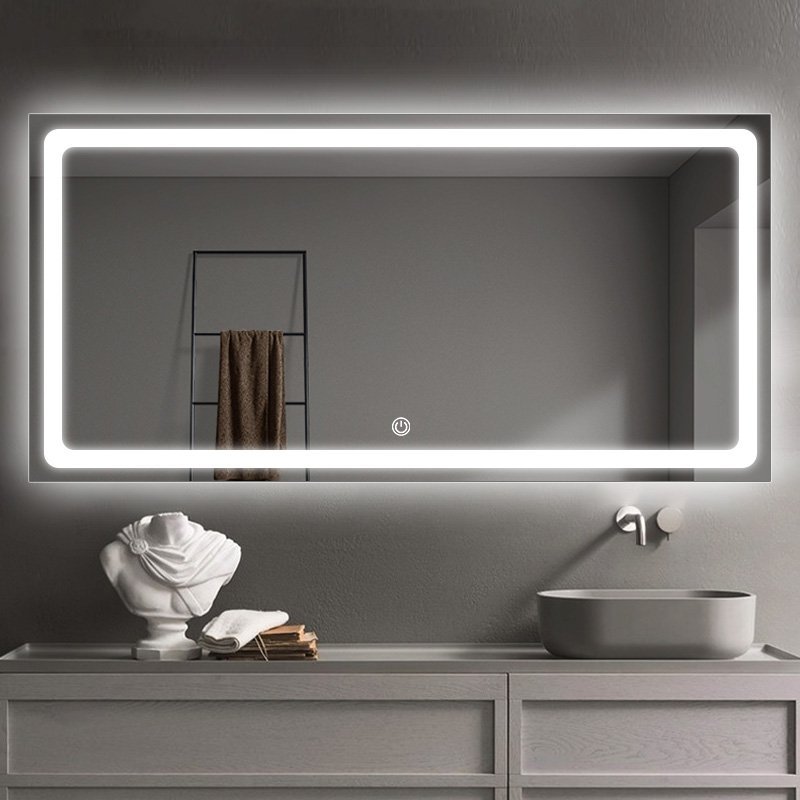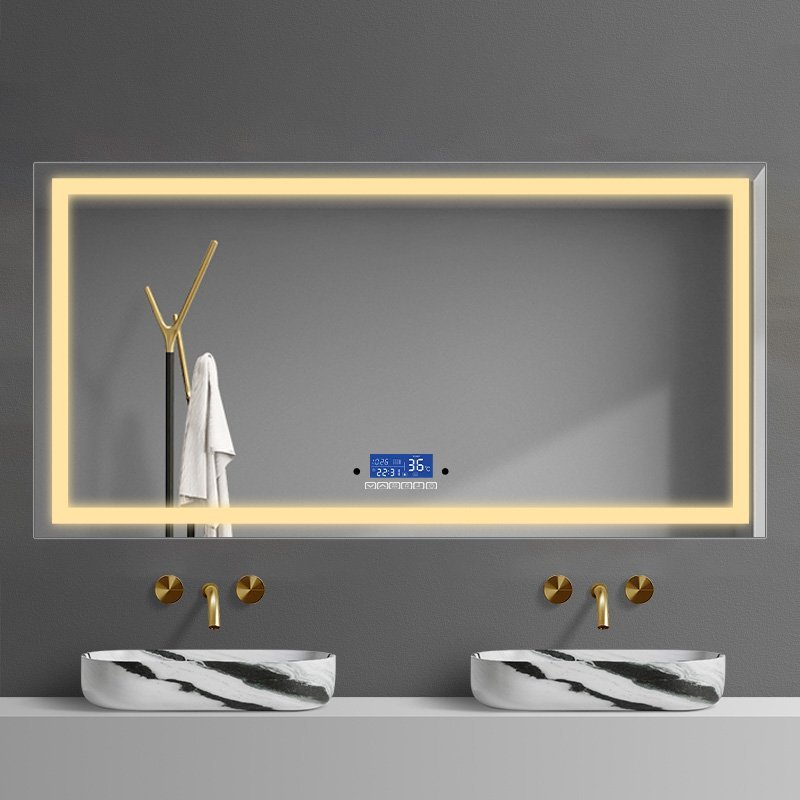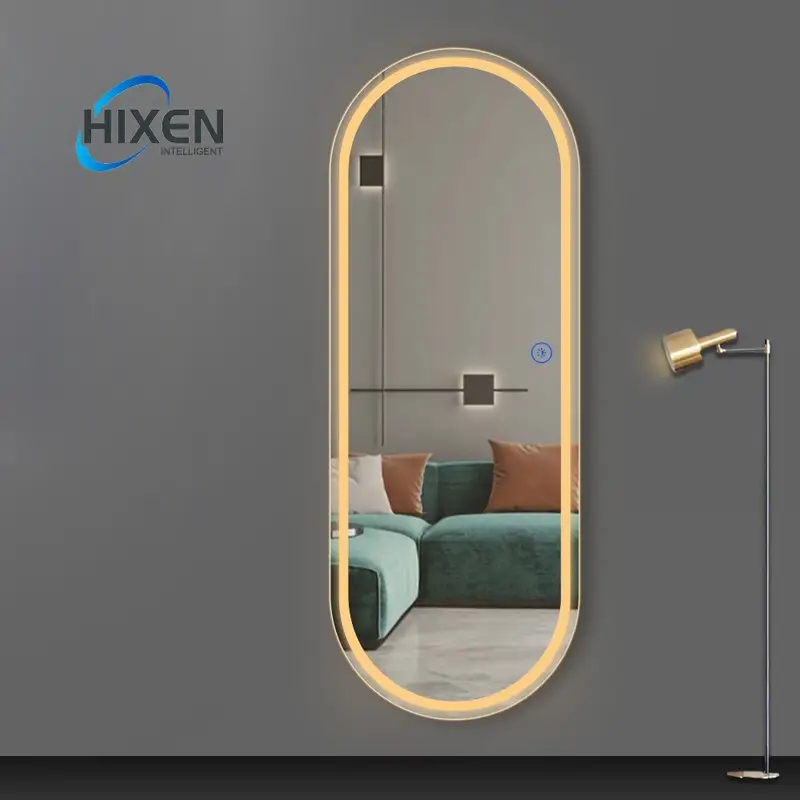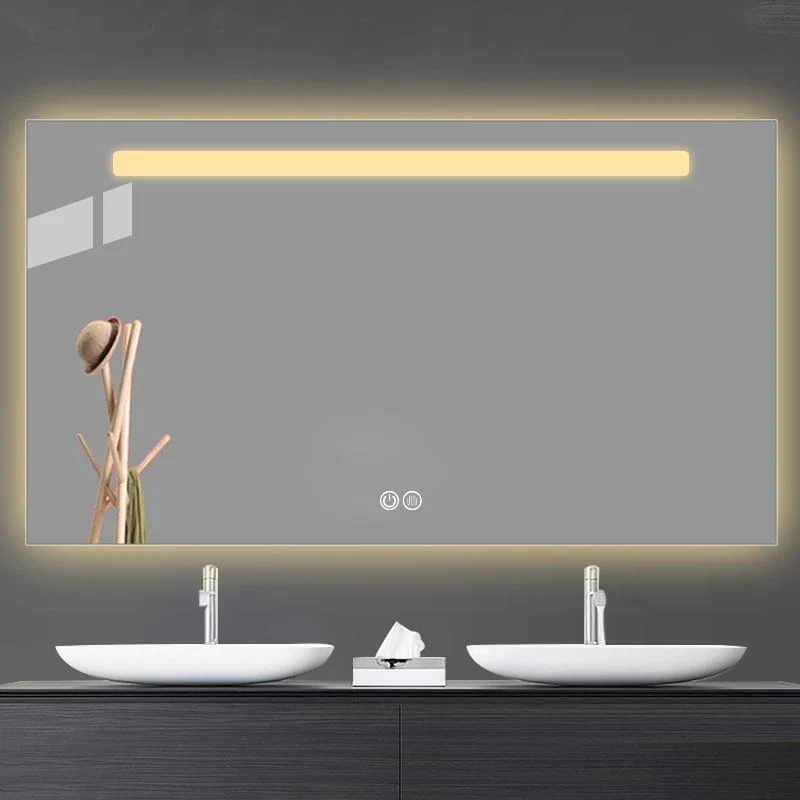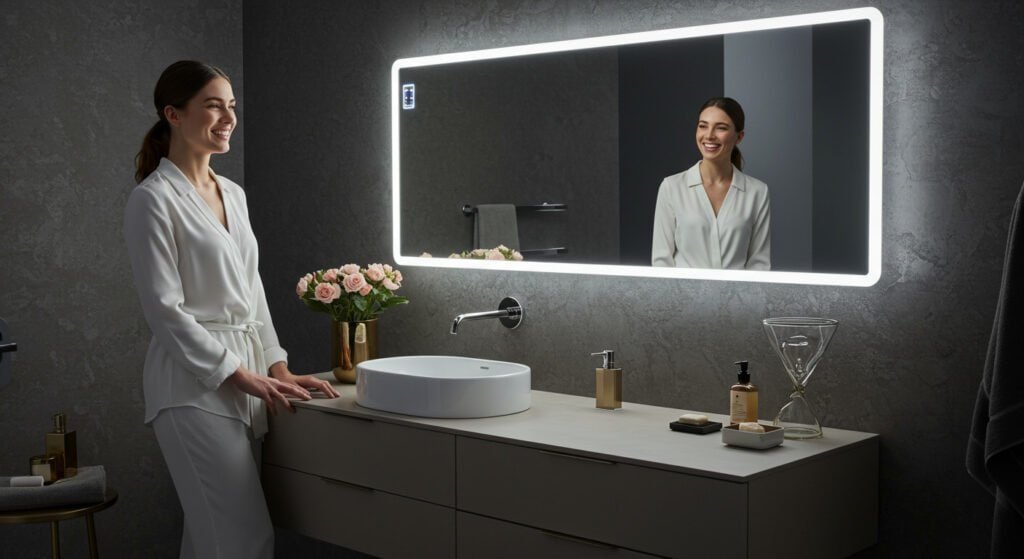|
Getting your Trinity Audio player ready...
|
Choosing the wrong mirror size can leave your bathroom looking unbalanced and limit functionality. How Big Should a Bathroom Mirror Be?
A bathroom mirror should typically be 2-4 inches narrower than your vanity, with height ranging from 30-40 inches depending on ceiling height and user requirements. Standard widths range from 24-60 inches, while proper height placement is usually 5-10 inches above the sink.
Let’s explore all the factors that determine the perfect mirror size for your specific bathroom situation.

What is the Standard Size of a Bathroom Mirror?
Understanding standard dimensions helps narrow down your options when shopping for the perfect bathroom mirror.
Standard bathroom mirror size typically ranges from 24-60 inches in width and 30-40 inches in height. These measurements work well with most residential vanities and provide adequate reflection area while maintaining proper proportion with other bathroom fixtures.
The bathroom mirror industry has developed these standards based on decades of design experience and consumer preferences. Most manufacturers produce mirrors within these ranges because they accommodate average-height users while standing at standard vanity heights.
When shopping for ready-made options, you’ll notice most fall within these parameters, though custom sizing is always available for unique spaces. BFY offers a wide range of standard sizes for their LED mirrors but also provides customization options for those with non-standard requirements.
What is the Rule for Mirror Size?
Following basic proportional rules ensures your bathroom mirror looks intentional rather than mismatched with your vanity.
The general rule for bathroom mirror sizing is that the mirror should be 2-4 inches narrower than your vanity or sink area, centered above it, with the height determined by ceiling height and the tallest user’s eye level. This proportion creates visual balance while ensuring functionality.
This rule exists because it creates aesthetic harmony while serving practical needs. When a mirror extends beyond the vanity width, it can create an unbalanced look. The standard mirror height from floor should allow comfortable viewing for all household members – typically positioning the mirror’s bottom edge 5-10 inches above the sink and extending to at least 4-5 feet from the floor.
For double vanities, you might choose one large mirror spanning the entire width or two separate mirrors positioned above each sink. Either way, maintaining proper proportions will create a cohesive bathroom design that feels intentional and refined.
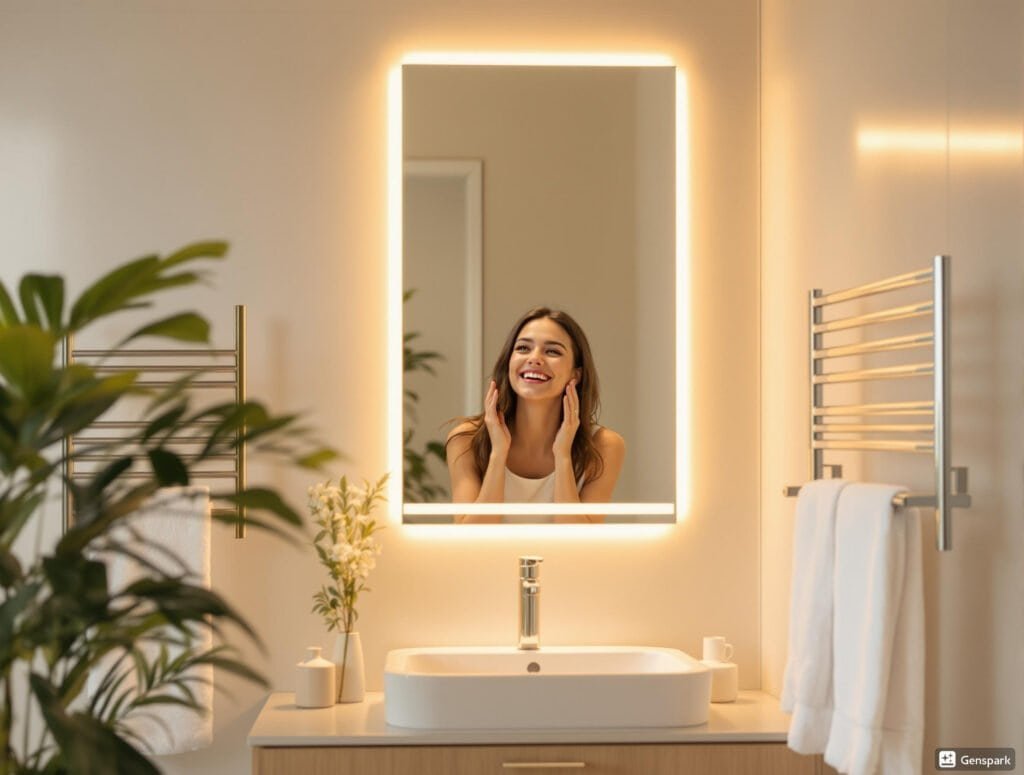
How to Measure for the Perfect Bathroom Mirror?
Proper measurement ensures you purchase the right size mirror without costly mistakes or returns.
To measure for a bathroom mirror, first determine your vanity width, then subtract 2-4 inches for the ideal mirror width. For height, measure from 5-10 inches above your faucet to at least 4-5 feet from the floor, adjusting based on ceiling height and user requirements.
Begin by using a tape measure to determine your vanity’s exact width from edge to edge. The height of bathroom mirror above sink typically starts 5-10 inches above your sink’s backsplash or faucet. The top edge should be at least at eye level for the tallest person using the bathroom. Don’t forget to account for lighting fixtures that might be installed above or alongside the mirror. Bathroom mirror placement over vanity should be centered for visual balance. Take photos and measurements with you when shopping, or provide these exact dimensions when ordering custom mirrors from suppliers like Hixen, who can manufacture LED mirrors to precise specifications.
How Big Should a Bathroom Mirror Be Calculator
A simple calculation can help determine the optimal mirror dimensions for your specific bathroom layout.
To calculate ideal bathroom mirror size, use this formula: Mirror width = Vanity width minus 2-4 inches. Mirror height = Floor-to-ceiling height multiplied by 0.25, plus 30 inches (minimum). The bathroom mirror size calculator provides proportional dimensions suited to your space.
Let’s apply this to real situations. If you have a 36-inch vanity, your ideal mirror width would be 32-34 inches. For height calculation in a standard 8-foot ceiling bathroom (96 inches), you would calculate: (96 × 0.25) + 30 = 54 inches maximum height. These calculations serve as starting points, but adjustments should be made based on other design elements and wall space. Many online bathroom mirror size calculators can help with these calculations, though understanding the basic formulas allows you to make adjustments for your specific needs.
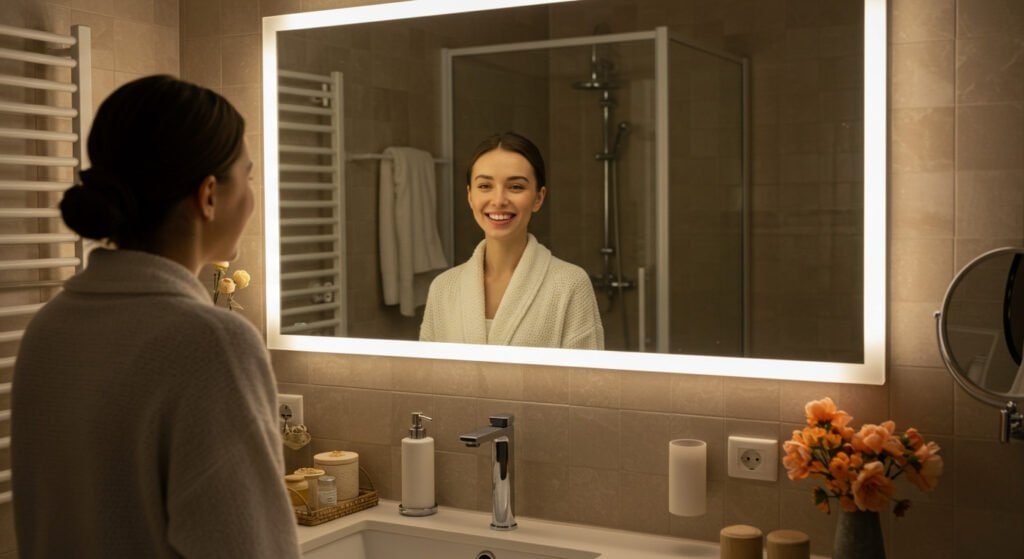
What Size Mirror for 60 Inch Vanity?
Larger vanities require careful consideration to maintain proper proportion and functionality.
For a 60-inch vanity, choose either one large mirror measuring 56-58 inches wide, or two separate mirrors each 24-28 inches wide with 4-6 inches between them. Height should be proportional to width, typically 30-40 inches, depending on wall space and ceiling height.
When selecting a mirror for a 60-inch vanity, consider whether it serves two sinks or one extended counter area. For double sinks, the two-mirror approach often works best, with each mirror centered above its respective sink. For a single extended vanity, one large mirror creates a more cohesive look while maximizing reflection space. Many homeowners with 60-inch vanities opt for led light mirror vanity designs that incorporate integrated lighting, which enhances functionality while adding a modern aesthetic. The vanity mirror size guide principles still apply – keep the mirror slightly narrower than the vanity and ensure proper height for all users.
How High You Should Hang a Bathroom Mirror Over Vanity?
Proper height placement ensures comfort and functionality for all bathroom users.
A bathroom mirror should be hung with its bottom edge 5-10 inches above the sink or faucet, and its top edge reaching at least 5-6 feet from the floor to accommodate taller users. This placement provides optimal viewing for most adults while maintaining aesthetic proportions.
When determining exact placement, consider the height of all household members. The mirror should allow everyone to see their full face without straining. If you’re installing bathroom light for mirror above the mirror, ensure there’s adequate space between the top of the mirror and the lighting fixture (usually 3-5 inches). For families with children, consider a longer mirror that extends lower, or install a step stool for little ones. Remember that while these guidelines provide a starting point, your specific bathroom layout, including ceiling height and other fixtures, might require adjustments to these measurements.
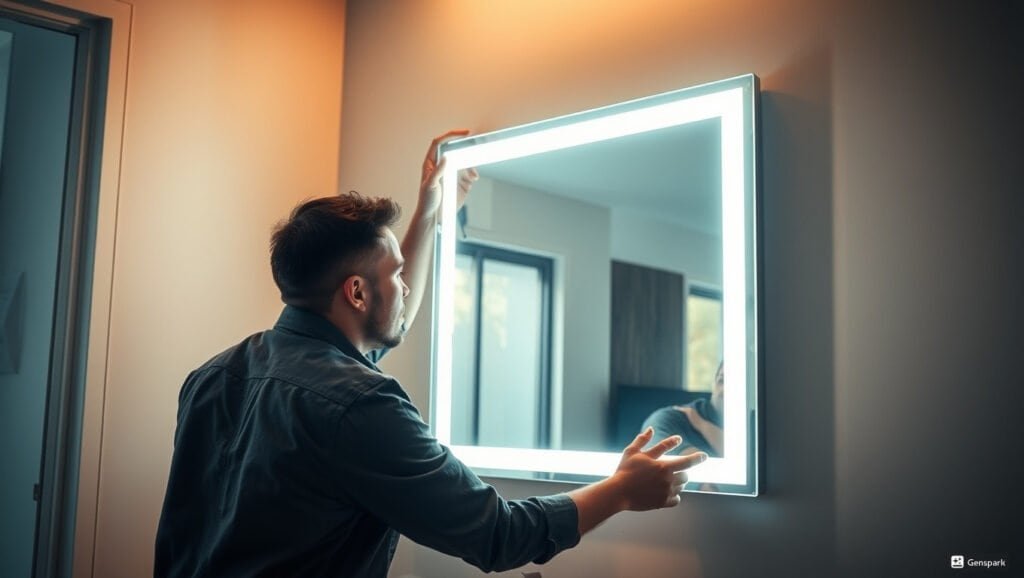
Is it Better to Have a Big or Small Mirror in the Bathroom?
The optimal mirror size depends on your specific bathroom needs and design goals.
A larger bathroom mirror creates the illusion of more space, provides reflection for multiple users simultaneously, and maximizes light reflection. Smaller mirrors create focal points, work better in powder rooms, and allow for more wall décor options. Your choice should balance functionality with aesthetic preferences.
Consider your daily routines when deciding. If multiple people need to use the mirror simultaneously during busy mornings, a larger mirror or multiple mirrors might be practical. For powder rooms or guest bathrooms with limited use, smaller decorative mirrors might be sufficient.
Wall mirror with lights options work well in both scenarios, as the integrated lighting enhances functionality regardless of size. LED mirrors in particular offer excellent illumination while maintaining slim profiles that work well in even smaller bathrooms. Remember that mirror size significantly impacts the overall feel of your bathroom – larger mirrors create a more open feeling while smaller mirrors allow for more design flexibility with other wall elements.
What is a Plane Mirror?
Understanding different types of mirror helps determine which is best suited for your bathroom needs.
A plane mirror is a flat, smooth reflective surface that produces images that are upright, left-right reversed, and the same size as the object. This is the most common type of mirror used in bathrooms, offering accurate reflections without distortion.
Among the various types of mirror available, plane mirrors are preferred for bathrooms because they provide true reflections without magnification or distortion. Convex mirrors (which bulge outward) make objects appear smaller and farther away, while concave mirrors (which curve inward) can magnify certain areas.
For bathroom applications, plane mirrors are typically used as the main mirror, sometimes complemented by smaller magnifying mirrors for detailed tasks like makeup application or shaving. Modern bathroom mirrors often incorporate advanced features while maintaining the plane mirror’s flat surface – options like backlit mirror designs provide ambient lighting while maintaining the true reflection qualities of traditional plane mirrors.

When Was Mirror Invented?
The history of mirrors provides context for their evolution into modern bathroom fixtures.
The first mirrors were created around 6000 BCE using polished obsidian, while metal mirrors appeared around 4000 BCE in Mesopotamia. Glass mirrors with metal backing similar to modern designs emerged in the 1st century CE, but high-quality glass mirrors only became common during the Renaissance in Venice.
The evolution of mirrors from polished stones to modern glass mirrors with perfect reflections spans thousands of years. Early civilizations used polished metals like copper, bronze, and later silver to create reflective surfaces. The breakthrough in mirror technology came when glassmakers in Venice developed methods for creating flat glass sheets and applying thin metal backings in the 16th century.
These techniques allowed for clearer, less distorted reflections than ever before. Today’s bathroom mirrors build on this technology, incorporating modern features like LED lighting, defogging capabilities, and Bluetooth connectivity while maintaining the basic principles of clear reflection that humans have sought for millennia.
Who Invented Mirrors?
The development of mirrors represents collective innovation across many civilizations rather than a single inventor.
Mirrors weren’t invented by a single person but evolved across civilizations. Early Egyptians, Greeks, and Romans all contributed to mirror development using polished metals. The most significant advancement came from Venetian glassmakers in the 16th century, who perfected flat glass production and silvering techniques.
These Venetian craftsmen on the island of Murano guarded their mirror-making secrets closely, as their techniques produced unprecedented clarity and reflection quality. Their innovations made mirrors more accessible to wealthy Europeans, though they remained luxury items.
By the 19th century, the invention of the silver nitrate deposition process by German chemist Justus von Liebig revolutionized mirror production, making them more affordable and widely available. This technological progression continued through the 20th century with the development of aluminum-based mirrors and eventually led to the sophisticated light up vanity mirror designs we see today, which incorporate LED technology and smart features while building on centuries of mirror-making innovation.
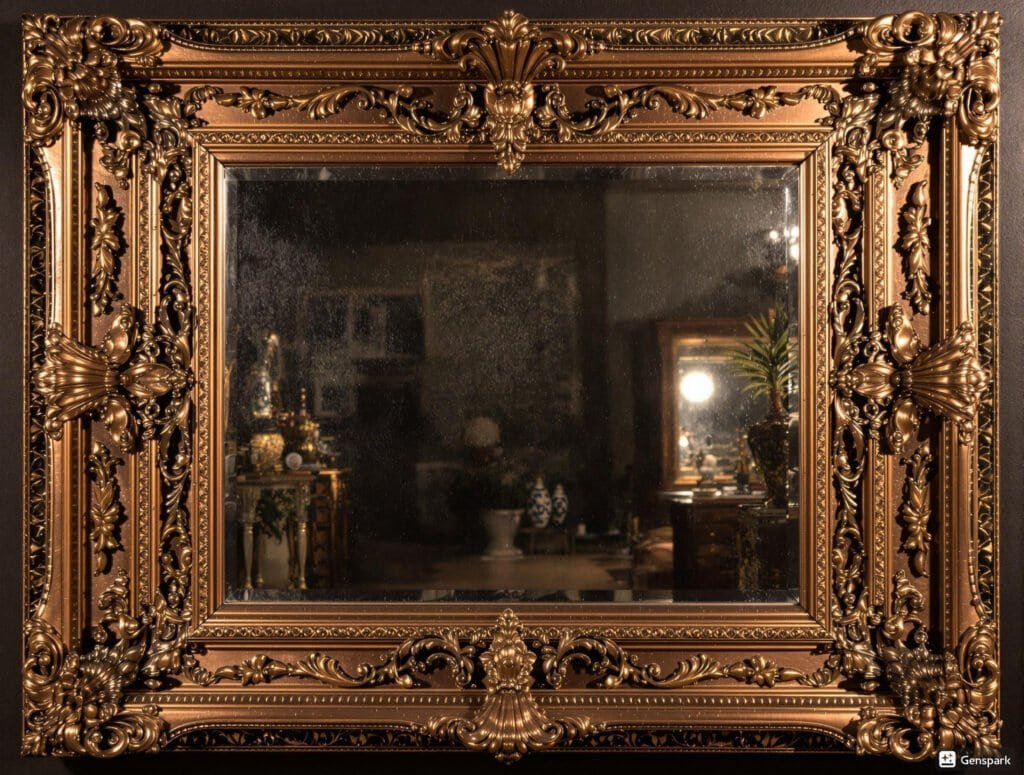
When Did Mirrors Become Common?
Understanding the timeline of mirror availability offers perspective on their evolution as bathroom fixtures.
Mirrors became relatively common among wealthy households during the 17th-18th centuries, but remained luxury items until the industrial revolution. Mass production in the late 19th century finally made mirrors affordable for average households, leading to their standard inclusion in bathrooms by the early 20th century.
Before mirrors became common household items, people relied on still water or polished metal surfaces for reflections. The transformation of mirrors from rare luxury items to everyday necessities parallels the development of indoor plumbing and dedicated bathroom spaces.
As indoor bathrooms became standard in homes during the early 20th century, mirrors became essential bathroom fixtures. The mid-20th century saw further innovation with the integration of lighting around bathroom mirrors to improve functionality. This evolution has continued to the present day, with modern LED mirrors incorporating energy-efficient lighting, anti-fog technology, and even smart features like Bluetooth speakers and touch controls – innovations that would have been unimaginable to those using the first glass mirrors centuries ago.
LED Bathroom Mirrors and Size Considerations
LED mirrors offer additional functionality but require special consideration when sizing.
When selecting an LED mirror, allow for the additional 1-2 inches of frame width that houses the lighting elements. LED bathroom mirrors typically require proper electrical planning, so determining exact size and placement early in your renovation process is essential.
LED mirrors come in various configurations – backlit mirrors create ambient lighting with a halo effect around the mirror, while LED light mirror vanity designs have lights integrated into the face of the mirror. These lighting options not only enhance functionality by providing optimal illumination for grooming tasks but also serve as striking design elements.
When measuring for LED mirrors, account for electrical outlets and switches that might interfere with placement. Hixen specializes in customizable LED mirrors that can be tailored to exact specifications, allowing for precise sizing that works with your existing bathroom layout. Their mirrors include features like defogging, Bluetooth connectivity, and color temperature adjustment, all while maintaining the proportional sizing guidelines discussed throughout this article.

Mirror Size Chart and Bathroom Layout Considerations
Reference charts can help visualize appropriate mirror sizes for different vanity widths.
A typical mirror size chart correlates vanity width to recommended mirror dimensions: 24″ vanity = 20-22″ mirror; 30″ vanity = 26-28″ mirror; 36″ vanity = 32-34″ mirror; 48″ vanity = 44-46″ mirror; 60″ vanity = 56-58″ mirror (or two 24-28″ mirrors).
When working with unusual bathroom layouts, these standard recommendations might need adjustment. For pedestal sinks without defined vanity widths, choose a mirror width that creates visual balance with the sink – typically 4-6 inches wider than the widest part of the sink. Corner vanities present unique challenges; consider oval or round mirrors that soften the angular space.
For wall-mounted floating vanities, maintain the same proportional relationship as standard vanities, but you might position the mirror slightly lower since floating vanities are typically mounted lower than standard height. Remember that mirror shape also impacts visual perception – round or oval mirrors can soften rectangular vanities, while rectangular mirrors create clean, defined lines that complement modern bathroom designs.
Conclusion
When selecting a bathroom mirror size, consider your vanity width, user height requirements, and overall bathroom dimensions. The perfect mirror balances functionality with aesthetic appeal while complementing your specific space and needs.
- To learn how to pick the right bathroom mirror click here.
- To learn how to install a mirror choose here.
- To learn how to pick the right size mirror click here.
- To learn how mirrors are made click here.
- Click here and you will learn why we look better in mirrors.
- Click here you will learn about the TOP 10 led mirror manufacturers for 2024.
- Click here to find out Why doesn’t my vanity mirror light come on?
- Find out How Tall Should Bathroom Mirror Be?Click Here
- Click here if you don’t know how to clean your mirror
- To find out how to fix Touch Sensor Mirror Not Working click here





